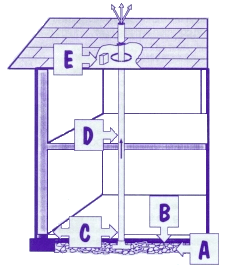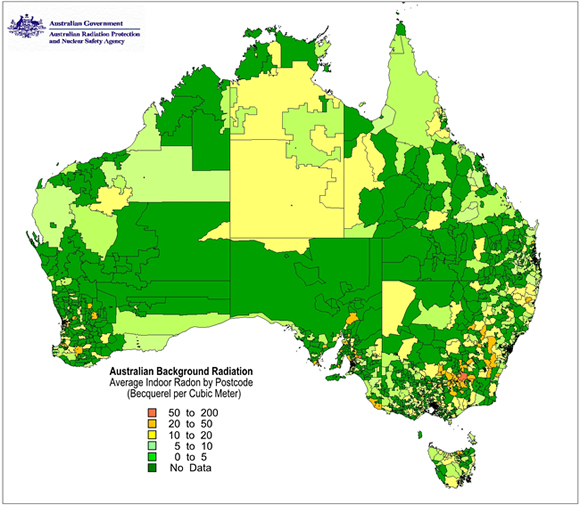Until very recently I'd never even heard that Radon in homes could be a problem, so when a friend of mine mentioned to me a few weeks ago that it might be a concern in an underground house I began looking into it. What I came across was a bunch of websites from the USA telling me about how it leads to lung cancer and I should be very worried about it, and here's who I can pay loads of money to to fix my home. Ka-ching!
I like to look a little deeper into things like that.
So, I started with what its all about anyway - where does it come from? Apparently, underground. The gist of it seems to be that Radon gas exists in the soil, at varying levels across the world, and slowly leeches up into the atmosphere. It's radioactive decay over time can contribute to lung cancer and other unpleasantness, particularly at high levels, though there doesn't appear to be useful data on 'safe' levels, just 'advisable' levels (US website are careful to make this distinction, the cynic in me thinks). The concern is that it enters houses through their foundations where it accumulates indoors due to the lack of air movement. This is apparently quite an issue in basements particularly.
So, on the surface at least, for someone wanting to build an essentially underground house this seems quite a worry. But I like to be thorough, so I started thinking about what factors contribute to the information gleaned above, which seems to be widely accepted as fact (at least by organisations trying to sell solutions, and the US government agencies charged with addressing the problem).
Firstly, it is clear that Radon levels vary from place to place. Much of the initial information I came across was from the US, describing it as unusually high compared to global levels. ARPANSA conducted an Australia-wide survey in the 1990s which seems to indicated Australian levels (¬11 Bq/m-3) are lower than elsewhere (¬40 Bq m-3).
Very comforting.
However, upon closer inspection this refers to the indoor levels only. This is significant because there's a possibility (indeed probability) that the variable causing the difference between areas relates to the type of house rather than any inherent difference in the Earth's crust. In truth, I would assume a bit of both. The plot thickens.
One can assume, for instance, that part of the issue in the US with basements is because they aren't as well ventilated as above-grade spaces, leading to an accumulation of Radon as it off-gasses through the foundation. One might also assume that in deep winter or the extremes of summer people actively seek to limit ventillation in their houses to keep air temperatures consistent and not waste all that energy-hungry air conditioning. It's unclear, though, how much this plays a part in geographical differences regarding Radon accumulation.
I could hypothesise based upon the above map (for example, I notice that the area of high concentration on the NSW/VIC border is an area in which it is both very hot in summer an very cold in winter, perhaps leading to accumulation due to lack of ventilation year round), however I have no way of finding out if this is in fact that case. It also just so happens that that very area of higher concentration is close to where we intend to build, so figuring out if it is an inherent difference in the earth's crust or some function of prevailing building and climate control techniques seems rather important.
As I have no way of knowing this (despite several hours of energetic googling on the subject) I turn instead to methods of limiting Radon accumulation as it seems like perhaps we should consider doing that anyway. Pleasantly, after a bit of searching, I found that the most effective methods are based around aspects of construction we will need to do anyway when building with earthbags. Problem solved!
Firstly [A] a permeable space below the floor (eg. gravel, which we have to do anyway for drainage). Secondly [B] a non-permeable layer above A but below the floor (eg. plastic, which is easy to add in during construction). Thirdly [C] sealing all openings in the floor (eg. around pipes, which one would want to do anyway). Next [D] a pipe from below the foundation to above the roof to allow the gas to disperse into the atmosphere rather than indoors (pretty easy to include during construction), and [E] a roughed in electrical box to put a fan in later (seems a little pointless, but I totally get that if you're going to do a thing do it properly).
There don't appear to be any regulations around controlling Radon levels indoors (although I may not be looking for the right thing there). So, given that the risk of Radon accumulation is essentially completely unknown (fancy government survey's not withstanding), but addressing the possible risk is pretty easy if done during construction and almost impossible if attempted later, I figure we might as well add in the pipe.
I like to look a little deeper into things like that.
So, I started with what its all about anyway - where does it come from? Apparently, underground. The gist of it seems to be that Radon gas exists in the soil, at varying levels across the world, and slowly leeches up into the atmosphere. It's radioactive decay over time can contribute to lung cancer and other unpleasantness, particularly at high levels, though there doesn't appear to be useful data on 'safe' levels, just 'advisable' levels (US website are careful to make this distinction, the cynic in me thinks). The concern is that it enters houses through their foundations where it accumulates indoors due to the lack of air movement. This is apparently quite an issue in basements particularly.
So, on the surface at least, for someone wanting to build an essentially underground house this seems quite a worry. But I like to be thorough, so I started thinking about what factors contribute to the information gleaned above, which seems to be widely accepted as fact (at least by organisations trying to sell solutions, and the US government agencies charged with addressing the problem).
Firstly, it is clear that Radon levels vary from place to place. Much of the initial information I came across was from the US, describing it as unusually high compared to global levels. ARPANSA conducted an Australia-wide survey in the 1990s which seems to indicated Australian levels (¬11 Bq/m-3) are lower than elsewhere (¬40 Bq m-3).
Very comforting.
However, upon closer inspection this refers to the indoor levels only. This is significant because there's a possibility (indeed probability) that the variable causing the difference between areas relates to the type of house rather than any inherent difference in the Earth's crust. In truth, I would assume a bit of both. The plot thickens.
One can assume, for instance, that part of the issue in the US with basements is because they aren't as well ventilated as above-grade spaces, leading to an accumulation of Radon as it off-gasses through the foundation. One might also assume that in deep winter or the extremes of summer people actively seek to limit ventillation in their houses to keep air temperatures consistent and not waste all that energy-hungry air conditioning. It's unclear, though, how much this plays a part in geographical differences regarding Radon accumulation.
I could hypothesise based upon the above map (for example, I notice that the area of high concentration on the NSW/VIC border is an area in which it is both very hot in summer an very cold in winter, perhaps leading to accumulation due to lack of ventilation year round), however I have no way of finding out if this is in fact that case. It also just so happens that that very area of higher concentration is close to where we intend to build, so figuring out if it is an inherent difference in the earth's crust or some function of prevailing building and climate control techniques seems rather important.
As I have no way of knowing this (despite several hours of energetic googling on the subject) I turn instead to methods of limiting Radon accumulation as it seems like perhaps we should consider doing that anyway. Pleasantly, after a bit of searching, I found that the most effective methods are based around aspects of construction we will need to do anyway when building with earthbags. Problem solved!
 |
|---|
Firstly [A] a permeable space below the floor (eg. gravel, which we have to do anyway for drainage). Secondly [B] a non-permeable layer above A but below the floor (eg. plastic, which is easy to add in during construction). Thirdly [C] sealing all openings in the floor (eg. around pipes, which one would want to do anyway). Next [D] a pipe from below the foundation to above the roof to allow the gas to disperse into the atmosphere rather than indoors (pretty easy to include during construction), and [E] a roughed in electrical box to put a fan in later (seems a little pointless, but I totally get that if you're going to do a thing do it properly).
There don't appear to be any regulations around controlling Radon levels indoors (although I may not be looking for the right thing there). So, given that the risk of Radon accumulation is essentially completely unknown (fancy government survey's not withstanding), but addressing the possible risk is pretty easy if done during construction and almost impossible if attempted later, I figure we might as well add in the pipe.

No comments:
Post a Comment